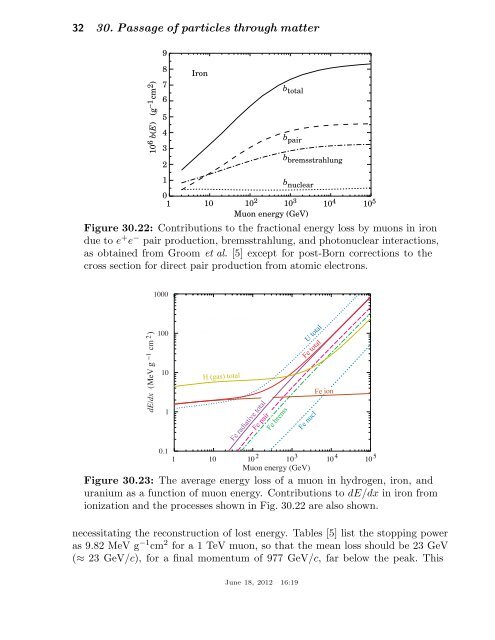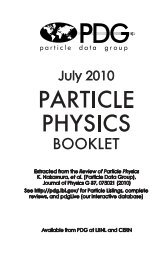30. Passage of particles through matter 1 - Particle Data Group
30. Passage of particles through matter 1 - Particle Data Group
30. Passage of particles through matter 1 - Particle Data Group
You also want an ePaper? Increase the reach of your titles
YUMPU automatically turns print PDFs into web optimized ePapers that Google loves.
32 <strong>30.</strong> <strong>Passage</strong> <strong>of</strong> <strong>particles</strong> <strong>through</strong> <strong>matter</strong><br />
10 6 b(E) (g −1 cm 2 )<br />
9<br />
8<br />
7<br />
6<br />
5<br />
4<br />
3<br />
2<br />
Iron<br />
b total<br />
b pair<br />
b bremsstrahlung<br />
1<br />
bnuclear 0<br />
10<br />
Muon energy (GeV)<br />
2<br />
1 10<br />
103 104 105 Figure <strong>30.</strong>22: Contributions to the fractional energy loss by muons in iron<br />
due to e + e− pair production, bremsstrahlung, and photonuclear interactions,<br />
as obtained from Groom et al. [5] except for post-Born corrections to the<br />
cross section for direct pair production from atomic electrons.<br />
Figure <strong>30.</strong>23: The average energy loss <strong>of</strong> a muon in hydrogen, iron, and<br />
uranium as a function <strong>of</strong> muon energy. Contributions to dE/dx in iron from<br />
ionization and the processes shown in Fig. <strong>30.</strong>22 are also shown.<br />
necessitating the reconstruction <strong>of</strong> lost energy. Tables [5] list the stopping power<br />
as 9.82 MeV g −1 cm 2 for a 1 TeV muon, so that the mean loss should be 23 GeV<br />
(≈ 23 GeV/c), for a final momentum <strong>of</strong> 977 GeV/c, far below the peak. This<br />
June 18, 2012 16:19







